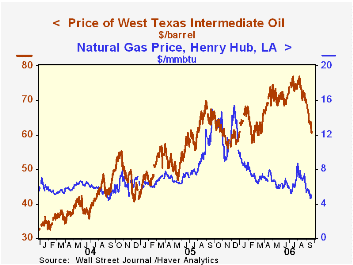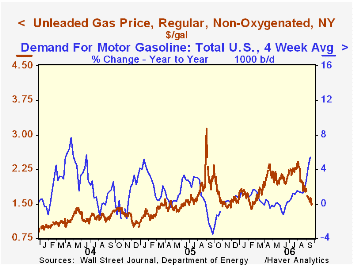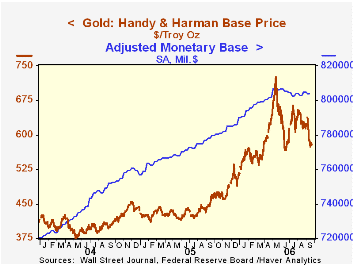 Global| Sep 22 2006
Global| Sep 22 2006Energy & Gold Prices Deflate
by:Tom Moeller
|in:Economy in Brief
Summary
At $61.05 yesterday for a barrel of WTI crude oil, the price has fallen 21% from this past summer's peak of $77.00.That decline has been accompanied by a 38% decline in the spot price for unleaded gasoline to $1.51 per gallon from [...]

At $61.05 yesterday for a barrel of WTI crude oil, the price has fallen 21% from this past summer's peak of $77.00.That decline has been accompanied by a 38% decline in the spot price for unleaded gasoline to $1.51 per gallon from $2.42 in July.
A lessening of supply concerns seems to more explain the price drop. Demand for gasoline actually has strengthened of late with y/y growth up to 5.4% during mid-September, according to figures from the U.S. Department of Energy.
Natural gas prices similarly have fallen sharply with the spot price down to $4.67/mmbtu, off by nearly one-half from this past July's high. During September, the Edison Electric Institute reports that growth in U.S. electricity demand was negative 5-11% y/y.
Gold prices have followed suit with a 20% decline to $578.75 per ounce versus the May high of $725.00. Reduced concerns about future inflation certainly figure in the price decline. Federal Reserve Board action has left the level of the monetary base virtually unchanged since the Spring with y/y growth down to 3.3%, near the lows of the last four years.An additional indication of reduced inflation risk is the Treasury market interest rate yield curve which remains inverted between the 10 Year and Fed funds.
Other commodity prices similarly have lost steam. The JoC-ECRI index of industrial metals prices has been volatile in a sideways pattern since the Spring though textile prices recently firmed off a low July base. Lower lumber prices reflect the declines in housing starts & sales. The framing lumber composite from FIBER near $300/1000 board ft. is off by nearly one third from last year's high.During the last twenty years there has been a 35% correlation between the y/y change in factory sector industrial production and the change in the crude goods Producer Price Index less food & energy. Inflation, Inflation Expectations, and Monetary Policy from the Federal Reserve Bank of Cleveland can be found here.
Inflation, Inflation Expectations, and Monetary Policy from the Federal Reserve Bank of Cleveland can be found here.
Monetary Policy in an Interdependent World from the Federal Reserve Bank of Cleveland is available here.
| Weekly Prices | 09/21/06 | 12/30/05 | Y/Y | 2005 | 2004 | 2003 |
|---|---|---|---|---|---|---|
| Light Sweet Crude Oil, WTI (per bbl.) | $61.05 | $61.04 | -8.2% | $58.16 | $41.78 | $32.78 |
| Gold: Handy & Harmon (per Troy Oz.) | $578.75 | $516.00 | 24.1% | $507.40 | $443.40 | $416.25 |
Tom Moeller
AuthorMore in Author Profile »Prior to joining Haver Analytics in 2000, Mr. Moeller worked as the Economist at Chancellor Capital Management from 1985 to 1999. There, he developed comprehensive economic forecasts and interpreted economic data for equity and fixed income portfolio managers. Also at Chancellor, Mr. Moeller worked as an equity analyst and was responsible for researching and rating companies in the economically sensitive automobile and housing industries for investment in Chancellor’s equity portfolio. Prior to joining Chancellor, Mr. Moeller was an Economist at Citibank from 1979 to 1984. He also analyzed pricing behavior in the metals industry for the Council on Wage and Price Stability in Washington, D.C. In 1999, Mr. Moeller received the award for most accurate forecast from the Forecasters' Club of New York. From 1990 to 1992 he was President of the New York Association for Business Economists. Mr. Moeller earned an M.B.A. in Finance from Fordham University, where he graduated in 1987. He holds a Bachelor of Arts in Economics from George Washington University.






